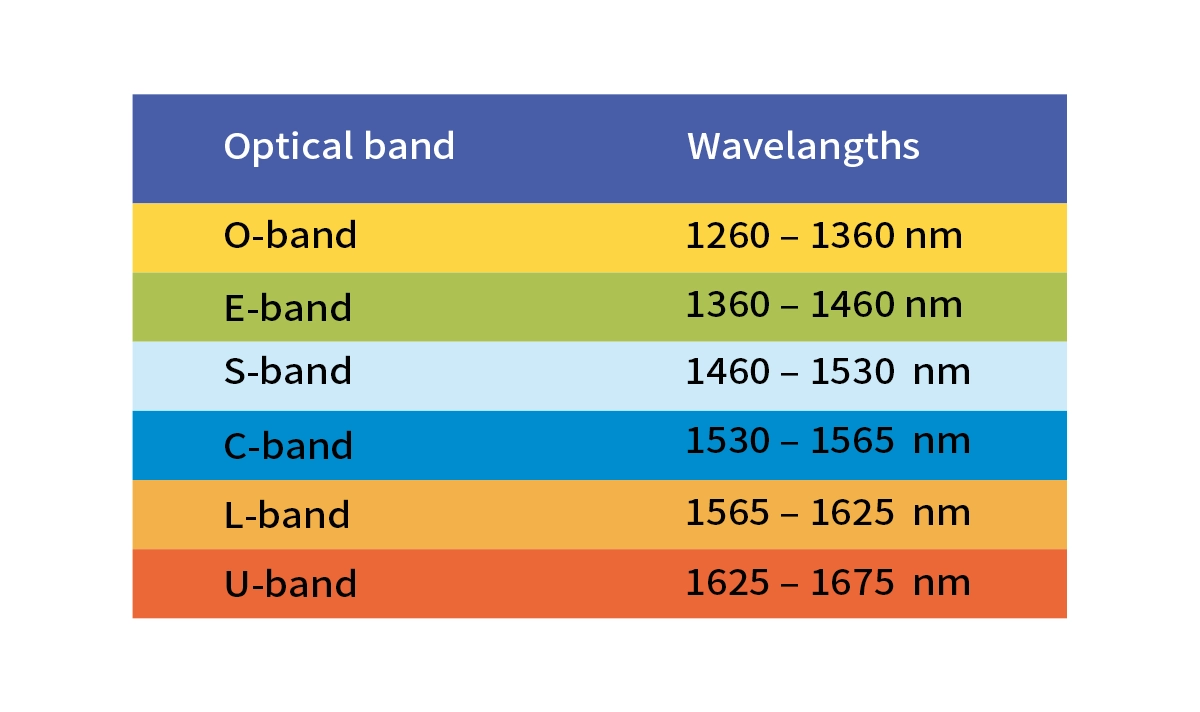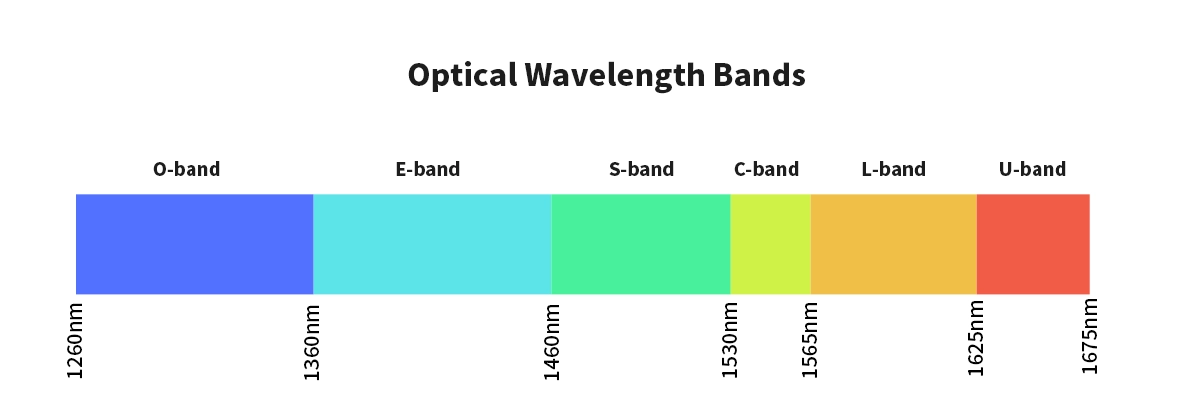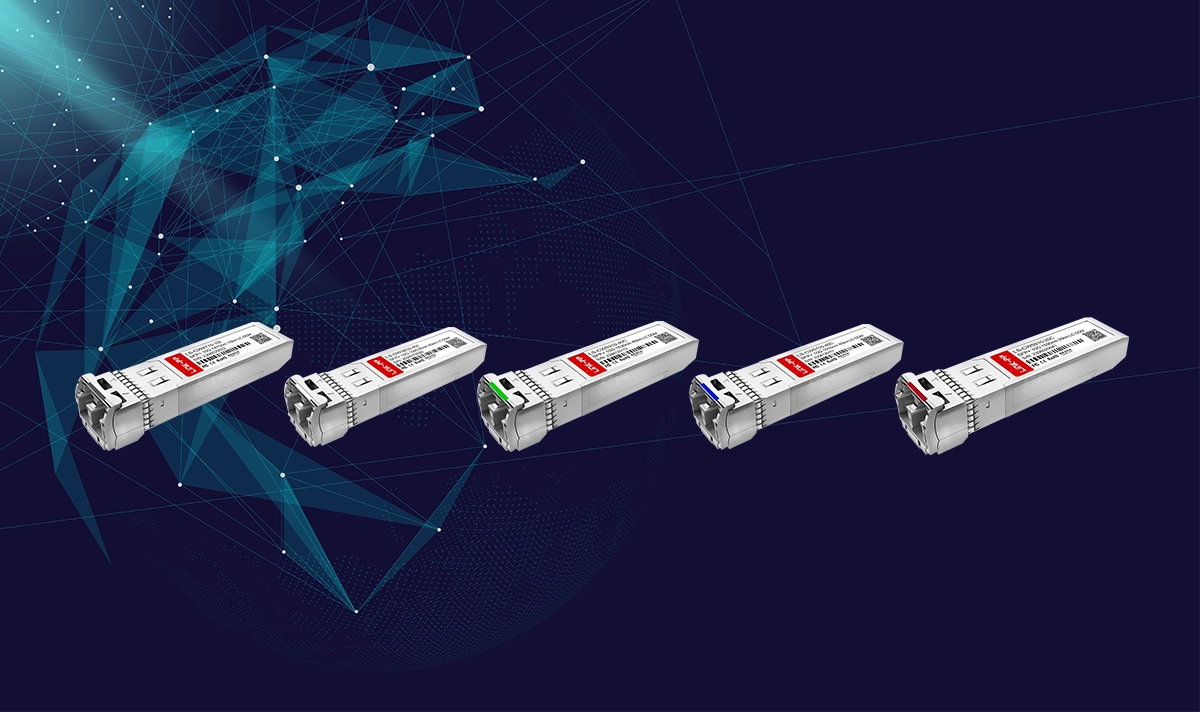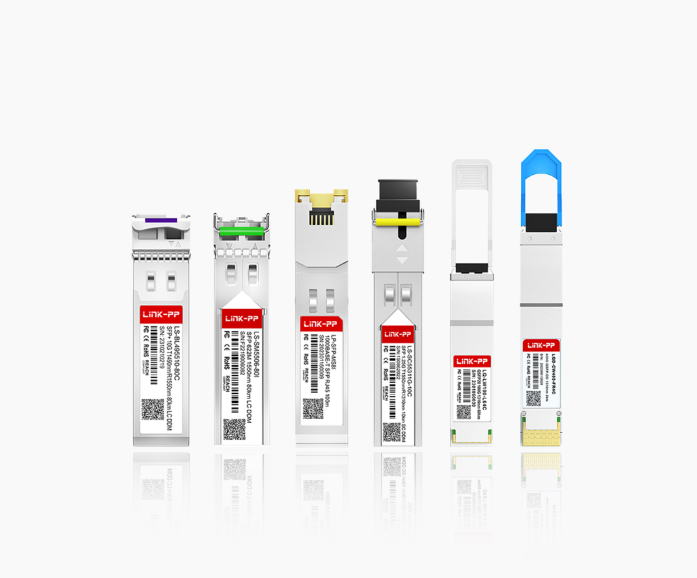📌 This article is reviewed and updated by LINK-PP engineers with extensive industry experience. For more about our team and technical contributions, visit About LINK-PP.
Introduction:
Fiber optic communication has revolutionized the way we transmit information across the globe. Unlike traditional copper cables that rely on electrical signals, fiber optics use light pulses to carry data, offering unparalleled speed, bandwidth, and immunity to electromagnetic interference. At the heart of this technology lies the concept of wavelength division multiplexing (WDM), which allows multiple light signals, each at a different wavelength (or color), to travel simultaneously through a single optical fiber. This efficient use of the fiber's capacity is made possible by the careful standardization of wavelength bands.
Understanding these standardized wavelength bands is crucial for anyone involved in the telecommunications industry, from network designers to equipment manufacturers. This blog post will delve into the various wavelength bands, their technical significance, the evolution of technologies that utilize them, and how they shape the future of global connectivity. We will also explore how LINK-PP, a leading provider of connectivity solutions, contributes to this ecosystem with its range of optical modules.
The International Telecommunication Union (ITU) has played a pivotal role in standardizing the wavelength bands used in fiber optic communication. This standardization ensures interoperability between different manufacturers' equipment and facilitates the global deployment of fiber optic networks. The primary bands, defined by their specific wavelength ranges, are as follows:

Standardized Wavelength Bands
★ O-Band (Original Band): 1260 nm to 1360 nm
Historically, this was the first band used for optical communication due to the availability of cost-effective lasers and detectors. It is characterized by zero chromatic dispersion, meaning different wavelengths of light travel at roughly the same speed, which minimizes signal distortion over long distances. However, it experiences higher attenuation (signal loss) compared to longer wavelengths.
★ E-Band (Extended Band): 1360 nm to 1460 nm
This band extends the O-band and was developed to increase the available bandwidth. However, it suffers from a significant water peak absorption at around 1383 nm, which historically limited its widespread use. Advances in fiber manufacturing have reduced this water peak, making the E-band more viable for certain applications.
★ S-Band (Short Wavelength Band): 1460 nm to 1530 nm
The S-band offers lower attenuation than the O-band and is used for some long-haul and metropolitan networks. It is often employed in conjunction with C-band and L-band systems to expand overall network capacity.
★ C-Band (Conventional Band): 1530 nm to 1565 nm
This is arguably the most crucial and widely used band in modern fiber optic communication. It offers the lowest attenuation in standard silica fibers and is where Erbium-Doped Fiber Amplifiers (EDFAs) operate most efficiently. EDFAs are essential for amplifying optical signals over long distances without converting them back to electrical signals, making the C-band ideal for long-haul and submarine cable systems.
★ L-Band (Long Wavelength Band): 1565 nm to 1625 nm
The L-band extends the low-loss window beyond the C-band. It is also suitable for EDFAs, allowing for further expansion of network capacity, especially in dense wavelength division multiplexing (DWDM) systems where multiple channels are packed closely together. The C-band and L-band together form the primary operating window for high-capacity optical networks.
★ U-Band (Ultralong Wavelength Band): 1625 nm to 1675 nm
This band is less commonly used but offers potential for future capacity expansion. It is still an area of research and development, with challenges related to amplification and component availability.
These standardized bands enable the efficient and reliable transmission of vast amounts of data, forming the backbone of the internet and global communication networks.

Key Technologies and Technical Evolution
The evolution of fiber optic communication is closely tied to advancements in component technologies that leverage these wavelength bands:
◆ Lasers and Detectors: Early systems primarily used LED and laser diodes operating in the 850 nm and 1310 nm windows. As demand for higher bandwidth and longer reach grew, more sophisticated Distributed Feedback (DFB) lasers and Avalanche Photodiodes (APDs) were developed for the 1550 nm window, offering higher power and sensitivity.
◆ Optical Amplifiers: The development of Erbium-Doped Fiber Amplifiers (EDFAs) was a game-changer for long-haul communication. EDFAs, operating primarily in the C-band and L-band, can amplify multiple optical signals simultaneously without converting them to electrical signals, significantly extending transmission distances and reducing system complexity. Other amplifier types, like Raman amplifiers, are used to extend the reach and capacity in other bands.
◆ Wavelength Division Multiplexing (WDM): WDM technology allows multiple optical signals, each at a different wavelength, to be transmitted over a single fiber. This dramatically increases the fiber's capacity. Coarse WDM (CWDM) uses wider channel spacing and is typically used for shorter distances and fewer channels, often in the O-band and E-band. Dense WDM (DWDM) uses much narrower channel spacing, enabling hundreds of channels to be transmitted over long distances, predominantly in the C-band and L-band.
◆ Modulation Formats: Beyond simply turning light on and off (On-Off Keying, OOK), advanced modulation formats like Quadrature Phase-Shift Keying (QPSK) and Quadrature Amplitude Modulation (QAM) allow more bits of information to be encoded per symbol, further increasing data rates. These complex modulation schemes require precise control over the optical signal and are often used in conjunction with coherent detection techniques.
◆ Fiber Types: While standard single-mode fiber (SMF-28) is widely used, specialized fibers like Dispersion-Shifted Fiber (DSF) and Non-Zero Dispersion-Shifted Fiber (NZDSF) have been developed to optimize performance in different wavelength bands, particularly for high-speed DWDM systems.
These technological advancements have continuously pushed the boundaries of data transmission, enabling faster speeds and greater capacities over ever-increasing distances.
LINK-PP Optical Modules: Connecting the World

LINK-PP, a trusted name in connectivity solutions, offers a comprehensive range of optical transceiver modules designed to meet the diverse needs of modern fiber optic networks. These modules are crucial components that convert electrical signals into optical signals and vice versa, enabling seamless data transmission across various wavelength bands. LINK-PP's commitment to quality and adherence to industry standards ensure that their products provide reliable and high-performance connectivity.
Band | Model | Reach | Typical Application |
|---|---|---|---|
O-band (1310 nm) | LS-SM3101-40C (SFP, 155 Mbps) | 40 km | Fast Ethernet, SDH/SONET, access networks, industrial control |
C-band (1550 nm) | LS-SM5510-80C (SFP+, 10GBASE-ZR) | 80 km | Long-haul Ethernet, metro DWDM, telecom backbone |
C-band (1530 nm CWDM) | LS-CW5310-20C (SFP+, CWDM) | 20 km | Scalable CWDM solutions in metro networks |
C-band (1545,32 nm DWDM) | LS-DW4010-40I (SFP+, DWDM) | 40 km | High-density DWDM links, industrial-grade environments |
By offering a wide array of optical modules across different wavelength bands, LINK-PP empowers network operators and system integrators to build robust, scalable, and efficient fiber optic infrastructures that can support the ever-growing demands for data.
Deployment and Industry Trends
The deployment of fiber optic communication systems is continuously evolving, driven by the insatiable demand for bandwidth. Several key trends are shaping the industry:
★ 5G Rollout: The global deployment of 5G networks is a major driver for fiber optic infrastructure. 5G requires dense networks of small cells, all of which need high-capacity fiber backhaul to connect to the core network. This is leading to increased demand for fiber deployment in urban and suburban areas.
★ Data Center Interconnect (DCI): The proliferation of cloud computing and hyperscale data centers has led to a massive increase in data traffic between these facilities. DCI solutions rely heavily on high-speed, high-capacity fiber optic links, often utilizing DWDM in the C-band and L-band to maximize throughput.
★ Fiber to the Home/Business (FTTH/FTTB): The push for faster internet speeds directly to consumers and businesses continues to drive FTTH/FTTB deployments. This involves bringing fiber directly to the premises, enabling gigabit and multi-gigabit internet services. Passive Optical Networks (PON) technologies, such as GPON and XG-PON, are commonly used for these deployments, often operating in the O-band and C-band.
★ Submarine Cables: These underwater fiber optic cables form the backbone of global internet connectivity, carrying the vast majority of international data traffic. They operate primarily in the C-band and L-band due to their ultra-low attenuation characteristics, enabling transmission over thousands of kilometers.
★ Coherent Optics: Coherent optical technology, which uses advanced modulation and digital signal processing, is becoming increasingly prevalent in long-haul and metro networks. It allows for higher data rates and improved spectral efficiency, pushing the limits of what can be achieved over existing fiber infrastructure.
★ Open Optical Networks: The trend towards open and disaggregated optical networks allows network operators to mix and match components from different vendors, fostering innovation and reducing vendor lock-in. This requires strict adherence to industry standards for interoperability.
These trends highlight the critical role of fiber optic communication in supporting the digital transformation across various sectors and underscore the ongoing need for advanced optical components and systems.
Frequently Asked Questions (FAQ)
Q1: Why are there different wavelength bands in fiber optic communication?
A1: Different wavelength bands are used to optimize data transmission based on factors like fiber attenuation, dispersion, and the availability of cost-effective optical components. Each band has unique characteristics that make it suitable for specific applications, such as long-haul transmission (C-band, L-band) or shorter-distance links (O-band).
Q2: What is Wavelength Division Multiplexing (WDM)?
A2: WDM is a technology that allows multiple optical signals, each at a different wavelength, to be transmitted simultaneously over a single optical fiber. This significantly increases the fiber's capacity without needing to lay more physical fiber.
Q3: What is the significance of the 1550 nm wavelength?
A3: The 1550 nm wavelength (within the C-band) is significant because standard silica optical fibers exhibit the lowest attenuation at this wavelength. Additionally, Erbium-Doped Fiber Amplifiers (EDFAs) operate most efficiently in this range, making it ideal for long-haul and high-capacity optical networks.
Q4: How do optical transceivers like those from LINK-PP fit into this?
A4: Optical transceivers are essential components that convert electrical signals into optical signals for transmission over fiber and convert optical signals back into electrical signals at the receiving end. LINK-PP's transceivers are designed to operate within specific standardized wavelength bands, ensuring compatibility and optimal performance within fiber optic networks.
Q5: What is the future of fiber optic communication?
A5: The future of fiber optic communication involves continued advancements in speed, capacity, and reach. This includes the development of new modulation formats, higher-order WDM systems, and potentially the utilization of new wavelength bands. The increasing demand for bandwidth from 5G, cloud computing, and IoT will continue to drive innovation in this field.
Conclusion:
The standardized wavelength bands are the fundamental building blocks of modern fiber optic communication, enabling the efficient and reliable transmission of the vast amounts of data that power our interconnected world. From the early days of the O-band to the high-capacity C- and L-bands, continuous innovation in optical technologies has pushed the boundaries of what is possible.
As the demand for bandwidth continues its exponential growth, driven by emerging technologies like 5G, AI, and the Internet of Things, the importance of understanding and leveraging these wavelength bands will only increase. Companies like LINK-PP, with their commitment to producing high-quality optical modules that adhere to these critical standards, play a vital role in building the robust and scalable network infrastructure of tomorrow. By working together, we can continue to illuminate the path forward for global connectivity.
🕓 This article was last reviewed and updated on June 30, 2025 to reflect the latest developments and standards in optical communication.
See Also
To further understand optical communication technologies and how LINK-PP solutions fit into modern networks, explore these related resources:




